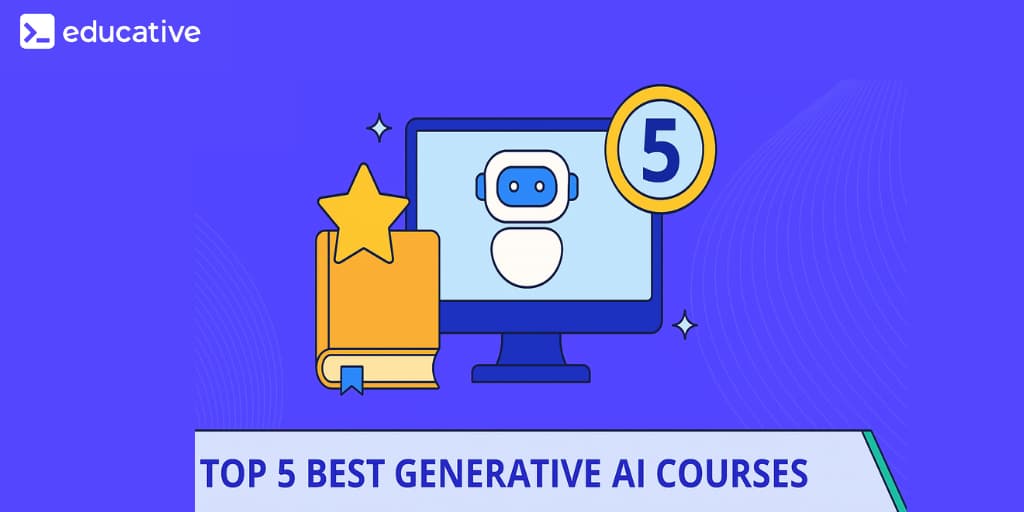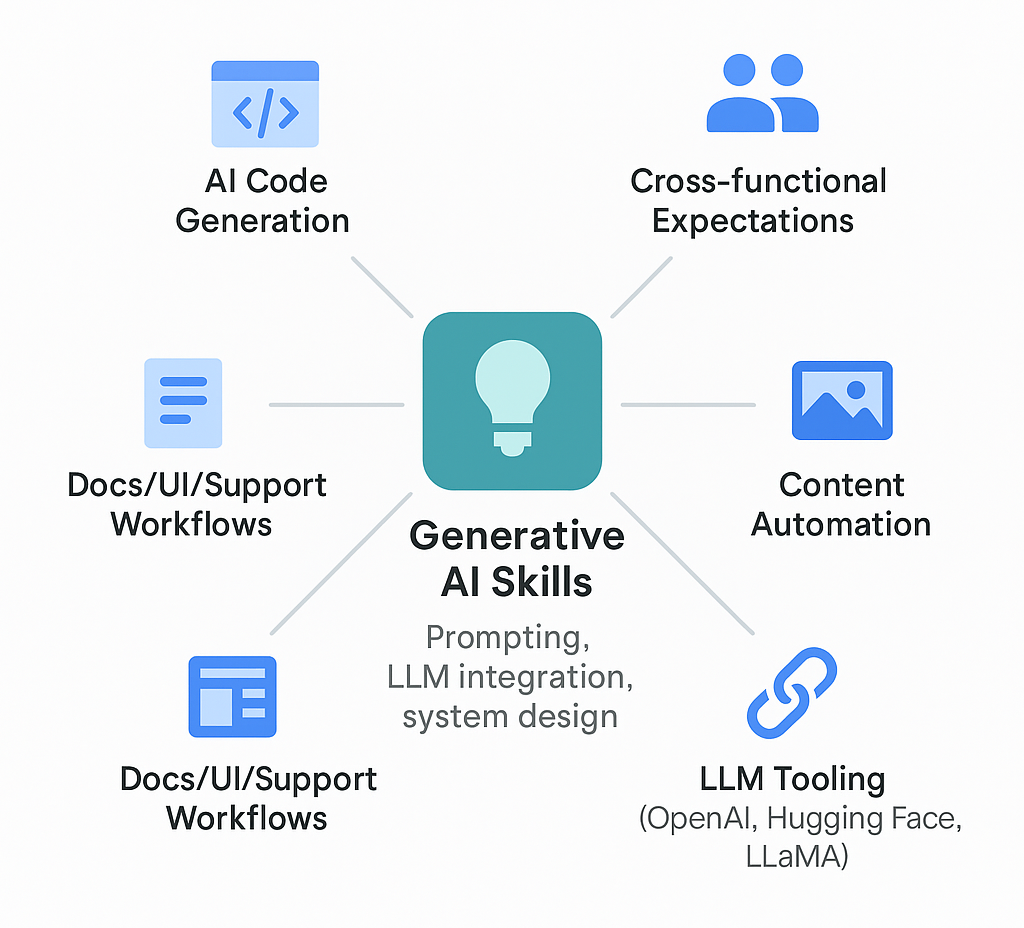Top 5 Best Generative AI Courses
Everyone wants to build with generative AI, but figuring out where to start? That’s where most developers get stuck. The field moves fast, and many tutorials are either too shallow, outdated, or assume you’ve already trained a transformer from scratch.
So we’ve narrowed it down. This list highlights the best generative AI courses for developers who want to build real tools, apps, and agents. Whether you’re brushing up on LLM internals or deploying production-grade workflows, these five resources will accelerate your learning.
Why generative AI skills are in demand#
Despite being something of a buzzword, Generative AI is increasingly a common infrastructure. From AI code generation and content automation to AI-first product interfaces, teams need engineers who can turn language models into usable systems.
Why this matters:
Creative workflows are being automated: Docs, UI generation, support responses, all powered by prompts.
Every dev stack is integrating LLMs: Hugging Face, OpenAI, and LLaMA-based tools are going mainstream.
Cross-functional expectations: PMs and stakeholders now assume AI can be part of the product.
Knowing how to work with GenAI is quickly becoming table stakes.
What makes a GenAI course worth taking?#
The best generative AI courses share a few key traits:
Hands-on with production-ready tools
Project-driven (you ship something real)
Regularly updated with the latest models
Built by practitioners, not just researchers
We chose the courses below based on utility, clarity, and depth. No fluff. No slides from 2021.
1. Generative AI essentials (Educative)#
Educative’s Generative AI essentials is built for engineers, not researchers. You’ll build transformers, wire up retrieval pipelines, and deploy LangChain-powered agents through interactive coding in the browser.
Generative AI essentials
Generative AI transforms industries, drives innovation, and unlocks new possibilities across sectors. This course provides a deep understanding of generative AI models and their applications. You’ll start by exploring the fundamentals of generative AI and how these technologies offer groundbreaking solutions to contemporary challenges. You’ll delve into the building blocks, including the history of generative AI, language vectorization, and creating context with neuron-based models. As you progress, you’ll gain insights into foundation models and learn how pretraining, fine-tuning, and optimization lead to effective deployment. You’ll discover how large language models (LLMs) scale language capabilities and how vision and audio generation contribute to robust multimodal models. After completing this course, you can communicate effectively with AI agents by bridging static knowledge with dynamic context and discover prompts as tools to guide AI responses.
What stands out:
Fully browser-based, no setup required
Covers vector stores, chaining, memory, and streaming
Keeps pace with emerging open-source models and tools
Best for: Backend and full-stack developers who want to quickly apply GenAI
2. Generative AI with LLMs (DeepLearning.AI & AWS)#
The Generative AI with LLMs course is designed for developers who want to scale GenAI apps beyond prototypes. You’ll learn prompt engineering, fine-tuning, RAG (retrieval-augmented generation), and deployment using tools like SageMaker and Amazon Bedrock.
What stands out:
Enterprise-ready tooling and deployment workflows
Deep dives into latency, cost trade-offs, and model selection
Built by instructors who’ve worked on production AI
Best for: ML engineers and architects working with cloud-scale infrastructure
3. Practical Deep Learning for Coders 2022#
If you want to understand the fundamentals under the hood, the Practical Deep Learning for Coders 2022 course delivers. While not GenAI-specific, it teaches you how to build, train, and optimize deep learning models using PyTorch.
What stands out:
Teaches you how to write training loops and custom models
Great for debugging and tuning LLM components
One of the most community-supported ML courses available
Best for: Devs with ML basics who want low-level control and model literacy
4. LangChain for LLM Application Development (LangChain YouTube & Docs)#
LangChain’s official content LangChain for LLM Application Development on YouTube, is perfect for developers already building LLM features. It focuses on chaining, tool integration, memory, and deploying GenAI flows.
What stands out:
Maintained by the LangChain team themselves
Lots of real-world examples and integrations
API-focused walkthroughs for shipping LLM tools
Best for: Builders using LangChain, LlamaIndex, or related orchestration frameworks
5. AI Programming with Python (Udacity)#
If you’re coming from zero experience, Udacity’s AI Programming with Python course builds your ML foundation. It teaches NumPy, PyTorch, neural networks, and inference, which are all prerequisites for generative AI.
What stands out:
Beginner-friendly with strong Python fundamentals
Bridges the gap between theory and code
Well-paced for self-learners and career switchers
Best for: Developers new to AI who want to grow into GenAI
The rise of domain-specific GenAI courses#
General-purpose GenAI courses are great for understanding the foundations, but today’s top professionals want more than just basics. As generative AI tools mature, developers, designers, and data scientists are turning to domain-specific GenAI courses that teach how to apply GenAI within their own fields.
You’re no longer just learning how a large language model works — you’re learning how to integrate one into a legal workflow, a game design pipeline, or an enterprise search engine. These courses focus less on the what of GenAI and more on the how of real-world implementation.
Here’s why domain-specific GenAI courses are on the rise:
Industry alignment: Courses now mirror the exact tools and tasks you’ll face in your role, whether you’re working in finance, healthcare, or education.
Tool specialization: You’ll explore how to fine-tune GenAI tools like ChatGPT, Claude, or Gemini for your domain-specific datasets or compliance requirements.
Real-world practice: Instead of just theory, these courses give you practice with debugging prompts, managing hallucinations, and aligning GenAI output with business goals.
If you want to stay competitive, it’s not enough to just “know GenAI.” You need to show you can use it in context, and that’s exactly what these courses offer.
The role of open-source tools in learning#
Learning generative AI without using open-source tools is like learning frontend development without touching HTML or CSS. Open libraries and frameworks form the backbone of modern GenAI stacks, and the best courses reflect that.
Hugging Face Transformers exposes students to real-world models, tokenizers, and pipelines.
LangChain and LlamaIndex teach orchestration, retrieval, memory, and agent abstraction.
Open weights and model hubs make experimentation faster and cheaper.
Courses that rely only on proprietary APIs limit your growth. You’re better off with ones that teach you how to build with open, forkable, and community-supported tools.
Pro tip: Check whether the course encourages cloning repos, tweaking configs, and building with open weights. That’s a green flag.
Certifications: Do they matter?#
Most companies hiring GenAI engineers care about what you’ve built, not what badge you’ve earned. That said, certifications can still:
Signal initiative if you’re switching careers
Help recruiters parse your resume
Serve as a structure if you need external accountability
But the real proof? A working demo in your GitHub.
How to choose the right generative AI course#
There’s no one-size-fits-all. Pick based on where you are:
Need production skills? Go with AWS x DeepLearning.AI or LangChain.
Want to code through concepts? Try Educative or fast.ai.
New to the field? Start with Udacity.
Whatever you choose, focus on courses that let you build. Concepts are great, but it’s pipelines, prompts, and shipped features that count.
Beyond the course: How to stay sharp#
Courses are only the beginning. To keep leveling up:
Contribute to Hugging Face or LangChain projects
Rebuild public GenAI apps and tweak their configs
Follow papers and repos on arXiv, GitHub, and Twitter/X
Try building your own prompt APIs or agents on weekends
The best engineers are serial experimenters.
Wrapping up#
Generative AI isn’t slowing down. These are the best generative AI courses because they go beyond theory, and they help you ship. Pick one. Code daily. And stay curious.
Because in GenAI, the fastest learners are the fastest builders.
Free Resources

